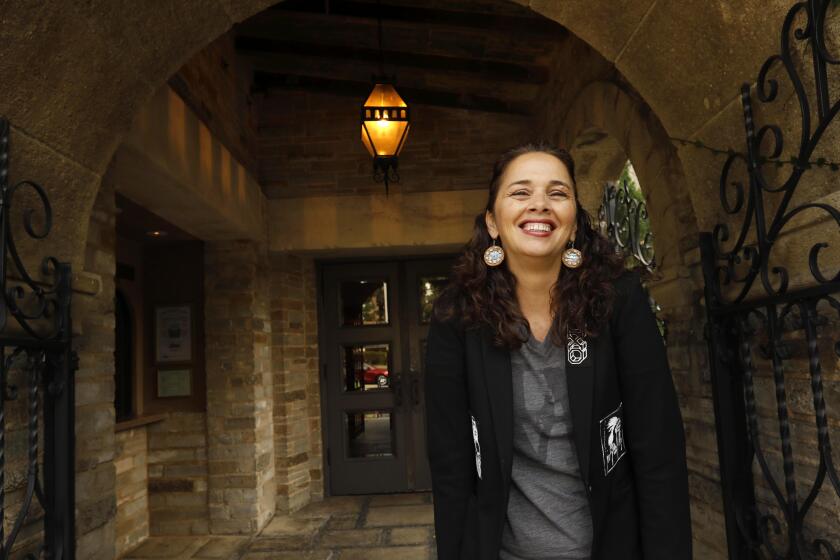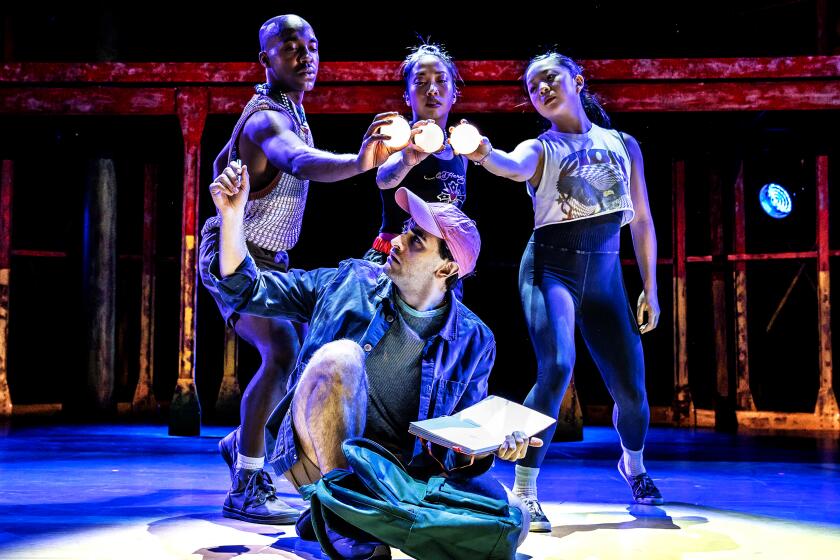At LACMA, a playground for Machine Project
A girl, tarred and feathered, and strangled by a bullwhip, was found in the corner of a quiet garden. Nearby, at the top of a two-story glass-brick facade, was a speed-metal guitarist pounding out Ted Nugent-like jams before a gothic archway -- complete with smoke machine and colored lights. Not far from that was a man covered from head to toe in a costume made entirely out of vintage black pepper canisters, which creaked and squealed as he moved.
No, this wasn’t the annual Burning Man festival but a carefully orchestrated daylong event at the Los Angeles County Museum of Art on Saturday.
It was directed by Mark Allen of the Echo Park-based Machine Project, which has been operating out of a small storefront at Alvarado Street and Sunset Boulevard for the better part of the last five years. Allen calls his space a gallery, although it’s less a commercial venue than it is a nonprofit laboratory, where a collective of artists and non-artists alike are encouraged to realize humorous, often beguiling artworks, performances and workshops of every stripe. As writer Gendy Alimurung once described it, “It’s Nikola Tesla by way of P.T. Barnum, with a dash of ‘The Anarchist Cookbook.’ ”
Allen first met co-organizer Charlotte Cotton, LACMA’s curator of photography, late last year when she was introduced to Machine Project through UCLA professor of photography James Welling. A short time later, Allen and Cotton came up with the idea of creating an interactive “field guide” for the museum, which was “not necessarily to come up with more artworks,” explains the 38-year-old, Vermont-born Allen, “but to use the space in a way that would encourage people to explore the entire museum and see things in a new way.”
That led to nearly 10 months of meetings and tours of the grounds, where Allen brainstormed with 30 L.A.-based artists, many of whom were veterans of Allen’s gallery. By summer, they had nearly 400 possible scenarios, as playful and odd as anything done at Machine Project, including ideas for giant lawn darts, whoopie cushions on every seat and a Saint Bernard with a brandy cask on its neck wandering the halls of landscape paintings. “I eventually sorted those into projects that were too expensive, projects that just weren’t funny anymore, and projects that were just impossible,” says Allen. “I think we ended up with about 100.”
Even still, Cotton had to steer Allen away from ideas that would have been problematic, for obvious reasons. For instance, the group wanted to replace the museum’s valets with a student driving school, conduct skiing classes down some of the escalators and have the security guards embark on a “disinformation campaign,” where they would deliberately mislead gallery-goers. “Fortunately, they had plenty of backup ideas,” says Cotton with a laugh.
Indeed, there were more than 60 site-specific artworks, performances and workshops Saturday that ran from noon to 10 p.m. and included the efforts of nearly 250 volunteers. There were so many, in fact, that it was impossible to take part in each one. But it was clear that most visitors were having an enjoyable experience. After one of the brief, hourly performances by the heavy-metal guitarist who stood before an ornate archway copied from the museum’s medieval collection (from 15th century France), one young woman laughed and said, “That was about the coolest thing I’ve ever seen!”
Others giggled as they queued up to get a free haircut from one of three hairstylists stationed at the impromptu “Ambient Haircutting” salon in the BP Grand Entrance, which was accompanied by live electronica music. And there was something utterly charming about Douglas Irving Repetto’s “Foal Army,” composed of full-sized tables crafted on the spot and equipped with motors that allowed them to walk around the entrance plaza.
Accentuating art
Still others found poignancy in projects that engaged both the content and the aesthetics of the museum. Holly Vesecky’s “Sam Frantasy” entailed the re-creation of Sam Francis’ oil painting “Toward Disappearance” in flowers. Daniel Richert and Mathew Timmons’ “Ursonorous Disruptions” employed a 4-foot-tall device to record voices and sounds throughout the day, jumbling them together into artful cut-up compositions; it offered a fitting complement to Kurt Schwitters’ mixed-media work “Construction for Noble Ladies” (1919).
Some of the less obvious pieces required a bit more time to appreciate. Few people picked up on the fact that Machine Project replaced the museum’s recording of “startled birds,” which is used to scare away stray fowl in the courtyard, with “welcoming” bird sounds. Most people walked right past the ball of string tied to the front door of the museum, which, unbeknownst to them, continued through the parking area and all the way to the front door of Machine Project six miles to the east. (It took artist Casey Rentz four hours to walk the string across the city.) And some were too busy to stumble across the skeleton of a life-size unicorn partially hidden in a quiet side garden near the Japanese art pavilion, which seemed to come directly from the adjacent tar pits.
Then there was Dawn Kaspar’s tarred and feathered corpse, splayed out in a carefully composed crime scene near Alexander Calder’s sculpture “Hello Girls.” That too went unnoticed by most, except for those who participated in the elaborate murder mystery, written by Jessica Z. Hutchins, which entailed finding clues at specific artworks and piecing together a believable scenario. (The winner received a yearlong membership to the museum.)
Not surprisingly, the cumulative effect of such ideas -- even if it was all a bit chaotic at times -- was cheerful and festive. That was partly the goal, Cotton says. But it was also “to find just the right balance of projects that fell somewhere between the witty and the lyrical, and projects that encouraged you to experience the museum in a way where you might fill it with your own imagination.”
On that score, “Field Guide” could be read as a poetic intervention of sorts, which comes close, at least in a spiritual sense, to Allan Kaprow’s happenings of the 1960s. But one can also read the entire affair as an anthem for Allen’s generation -- one that deliberately engages in issues of amateurism, participation, collectivism and, perhaps most crucially, relational aesthetics. (That last term surfaced in the 1990s to describe such projects as Gabriel Orozco’s installation of a hammock at the Museum of Modern Art’s garden in 1993.) After all, at the core of Machine Project’s aesthetic is the total embrace of the creative spirit without mystification, without irony, without heady theoretical constructs.
Make ‘em talk
That’s not to say that it doesn’t have a conceptual rigor. What’s crucial to Allen’s approach is that it bears no discernible aestheticizing attitude whatsoever. It’s mostly non-object-based art making that is designed to inspire conversations and connections more than judgments.
For Cotton, that places it in line with some of the humorous conceptual artworks of the 1960s, particularly those from the West Coast. “But I also believe that the work has a real pertinence to the time that we’re living in, whether it’s of a particular critical school or not,” she says. “And I don’t think that you could ever find such a fully formed network of artists in any other city, which are operating at this level and in a noncommercial and non-institutional way.”
Allen, who remained levelheaded and collected throughout the day, prefers to see his gallery’s aesthetic slightly differently. As he says, “All we’re trying to do is to look at all aspects of human culture with a kind of evenness,” he explains. “We’re just here to provide a space where people can learn about different ideas from every field imaginable, but to learn about them in ways that are hopefully enjoyable and encourage more learning and more creativity.”
Young is a freelance writer.
More to Read
The biggest entertainment stories
Get our big stories about Hollywood, film, television, music, arts, culture and more right in your inbox as soon as they publish.
You may occasionally receive promotional content from the Los Angeles Times.






